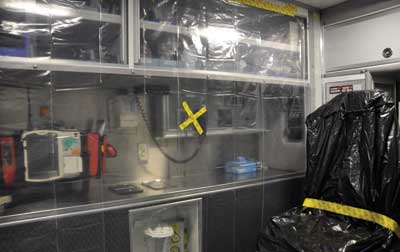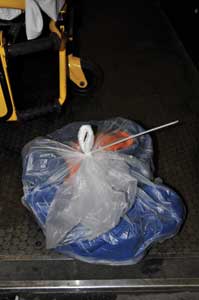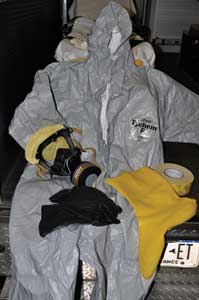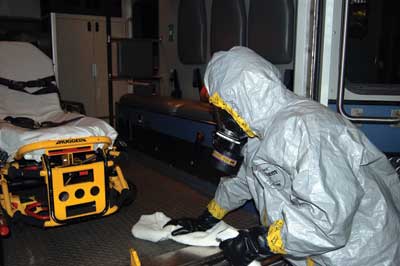BY FRANCIS CALIFANO
It’s the witching hour. You and your partner are in the last hours of a relatively quiet overnight tour. It looks as if it will be a slow beginning of a new day. Then, you hear: “Two-three Young, for the intox, Seaview and North Railroad on the platform, two-three Young.” You acknowledge the dispatcher, and your partner starts the rig for the all-too-familiar response to an all-too-familiar place.
You and your partner argue as to who this morning patient will be or whether a new citizen will make your acquaintance. You arrive at the station, assemble your gear, and head for the stairs to the platform. You encounter a lone gentleman slightly slumped over on a bench. You can see that he is breathing; things are looking good already. He responds to your voice but seems a bit lethargic. He begins to come around but is still a little slow on the uptake.
 |
| (1) A protected patient compartment. (Photos by author.) |
You ask the usual battery of questions: How do you feel? Anything bothering you? Chest pain? Difficulty breathing? How much have you had to drink? Most of your questions are answered with a couple of nods or a yes or a no. The patient is unkempt and appears to be homeless, given the fact that he has a well-traveled wheeled suitcase by his side. He appears to have been over-served and generally is not alert and oriented. A quick set of vitals reveals no abnormalities. He doesn’t seem to be able to ambulate well on his own, so you cannot leave him where he is. You assist him to the back of your ambulance for a morning jaunt over to the hospital emergency department (ED).
As you get the patient settled on your stretcher and your baggage handler/partner loads the luggage, you notice that this gentleman is somewhat malodorous. It is not the normal perfume you are accustomed to but a rather sharp, pungent odor that slowly starts to affect you. As you drive on, the smell gets worse, and your head begins to throb. You tell your partner to make haste to the hospital. By the time you reach the ED, you quickly bail out of the ambulance and are now having trouble breathing. Another crew assists your partner with off-loading the patient. They get the patient into the hospital; you follow. Once the patient is being triaged, you seek some assistance on your own. Your partner heads back out to the ambulance to retrieve the patient’s bag. He now notices, in the morning light, that the bag appears to be leaking something. He leaves it and calls for assistance.
 |
| (2) Contaminated clothing in a clear bag. Label the bag “contaminated.” |
The hazardous materials (hazmat) team arrives and begins to investigate. The members suit up and approach the bag cautiously. They give it a pass with a meter and a poke or two with some sample paper. Nothing positive. They move the bag to the ground and unzip it. They find two glass containers inside that contain malathion, a bug spray concentrate. Now, the back of your ambulance is a hot zone.
This type of encounter, once a rare occurrence, seems to be on the rise. With greater numbers of homeless people roaming our city streets and abandoned industrial complexes, these homeless people have become a source of potentially contaminated patients. We as first responders have become more susceptible to run-ins with chemically exposed patients, not to mention the uptick in the incidents involving “chemically assisted suicides.” The possibility of having to deal with a chemically contaminated patient has become more commonplace. The question is, are you prepared and trained to do so? How do we protect ourselves and our equipment?
ACTION PLAN
The first choice would be not to treat patients who have been exposed to hazmats. The reality is that emergency medical services (EMS) are often the first to arrive on scenes that initially had no indications of hazmats. It is not always possible to retreat and call for backup. The first priority, once it is determined a hazmat is involved, is safety-yours and your partner’s. Is it safe for the both of you to stay in the current environment? If so, the next action would be to isolate the patient. If the environment is untenable, you will have to retreat to a safe area. If you are able to maintain a safe zone around the patient, keep him calm; don’t let him walk away or come in contact with others. Finally, call for assistance. Notify the proper agency of a hazmat response.
 |
| (3) Level C suit and other PPE. |
A mechanism for remembering the action plan for a contaminated patient is SIN:
EMS personnel must continually evaluate whether a scene is safe. This evaluation must always go beyond an initial assessment. As information about the unfolding situation is uncovered, you must perform a “risk vs. benefit” analysis, recognize when the benefit outweighs the risk, and act accordingly. Dealing with hazmat contamination and exposure always creates a dynamic environment.
 |
| (4) Thoroughly clean the ambulance and equipment. Discard grossly contaminated objects. |
As with the scenario above, things can change quickly from what you initially perceived them to be. As the event unfolds, what precautions should responders take? It may not always be possible to keep a contaminated patient from getting into your ambulance, but you should make every effort to keep that from happening. If the patient is in immediate need of care, do the following.
- First, don appropriate personal protective equipment (PPE) including gloves (buytl rubber gloves offer good chemical protection); a full-face respirator with an organic vapor/Hepa/chemical-biological-radiological-nuclear-explosive-rated filter; goggles; rubber overboots; and a Level C suit that provides Level C protection as is required for the hazmat operations level. You should also carry on your ambulance a roll of CHEM tape.
- If the patient is in immediate need of care and is capable of following simple directions, have him get out of his clothing; this action will remove 70 to 80 percent of a contaminant. If the patient is not grossly contaminated, have him wrap himself in a blanket, preferably a disposable type with the mylar/plastic membrane.
- If you suspect the patient has ingested a hazmat (i.e., chemical-assisted suicide), be ready to deal with the possibility of contaminated emesis. Respiratory protection should be your first concern; inhalation is often the first way to be overcome.
- Prep the interior of your ambulance patient compartment. Cover the floor, patient area, and any equipment in close proximity to the patient. Limit the amount of equipment exposed to contamination (i.e., trauma bag, ET kits, monitor). PVC sheeting or paint drop cloths work well.
- Secure and leave at the scene any patient belongings suspected of being contaminated or possibly containing a hazmat. If this is not possible, double bag and securely seal them (cable ties work well). Use clear bags so that the clothing can be seen through the bag. Mark the clothing package “contaminated,” and dispose of it once the scene is stabilized.
- Ensure there is proper ventilation; open windows and vents.
- Notify the receiving facility.
- Terminally clean the ambulance and equipment; properly dispose of anything grossly contaminated.
TRAINING
In general, hazmat training for EMS personnel has been minimal at best. In 2009, the Occupational Safety and Health Administration (OSHA) published “Best Practices for Protecting EMS Responders during Treatment and Transport of Victims of Hazardous Substance Releases.” This document outlines what OSHA considers some of the “best practices” for training minimums, PPE, and response guidelines for EMS personnel:
| These best practices are intended to help EMS responders’ employers investigate and identify in advance of an incident the roles that their workers can be expected to play during a hazardous substance release event in their community. (OSHA, 2009, p. 44) |
In general, if you respond in a “first responder” capacity to “emergency” situations, you must be properly trained. OSHA states:
| First responder training at the awareness level is the minimum level of training required for EMS responders who respond to emergencies (including 911 calls) and might be first on the scene of an emergency but would not be expected to treat or handle a contaminated patient. (OSHA, 2009, p. 20) |
FIRST ON THE SCENE
How often EMS responders will arrive first on the scene with a hazmat depends on the community’s experience and practices. For example, first responders in some communities may be obliged to stop if they come on a transportation accident that has just occurred. The accident might involve a hazardous substance release. Furthermore, some communities dispatch EMS responders instead of police or firefighters to certain medical 911 calls. It is possible that those calls could involve hazardous substances that were not reported during the 911 call. If, in the initial stages of a response, the EMS responder could temporarily be the decision maker at the site until a more qualified incident commander arrives, that EMS responder requires both first responder operations level training [29 CFR 1910.120(q)(6)(ii)] and incident commander training [29 CFR 1910.120(q)(6)(v)].
Get trained. As the roles and responsibilities of EMS personnel evolve, so should our quest for training. If we are expected to perform in a given environment, we must ensure that we are properly trained to do so. Safety, safety, and safety should be the driving force behind our motivation to train. A basic knowledge of how to deal with a chemically contaminated patient should be the latest tool added to our EMS toolbox.
Reference
OSHA. (2009). Best Practices for Protecting EMS Responders during Treatment and Transport of Victims of Hazardous Substance Releases. Washington, D.C. http://www.osha.gov/Publications/OSHA3370-protecting-EMS-respondersSM.pdf.
● FRANCIS CALIFANO, BS, EMT-P, CHSP, is an emergency management coordinator for North Shore-LIJ Health System, Protective Services in Syosset, New York, assigned to the Emergency Management Division. He is a 30-year member of Rescue Hook & Ladder Co. #1 of Roslyn, New York. He is company safety officer and has served as captain of EMS. He has a bachelor of science degree in community services/emergency management from State University of New York, Empire State College. Califano is a certified hazardous materials specialist and a certified healthcare safety professional. He has taught at FDIC and other national conferences.
Enter 121 at fireeng.hotims.com
Fire Engineering Archives

